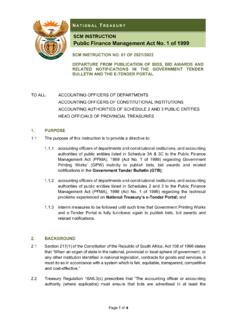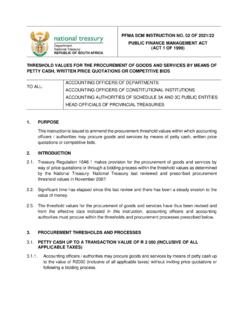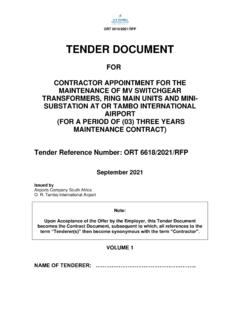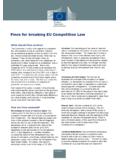Transcription of Cold Storage Chart & Reference Guide - Cornell University
1 Cold Storage Chart & Reference Guide Robert Hadad Regional Vegetable Specialist, CCE Cornell Vegetable Program Vegetable Recommended Temp Recommended Relative Humidity Max Time Held ------------------------- ( F) (%) (Weeks). Asparagus 32 90-95 1-2. Bean 45-50 85-90 1-2. Beet, topped 32 90-95 7-8. Broccoli 32 90-95 1-2. Brussels sprouts 32 90-95 4. Cabbage 32 90-95 12-16. Carrot, topped 32 90-95 16-20. Cauliflower 32 90-95 3-4. Chinese cabbage 32 90-95 8-12. Greens 32 90-95 1-3. Kohlrabi 32 90-95 4-8. Lettuce, head 32 90-95 2-4. Honey Dew 50-55 85-90 2-4. Muskmelon 45-50 85-90 1-2. Onion, dry 32 70-75 28.
2 Parsnip, topped 32 90-95 24-26. Pea 32 85-90 1-2. Pepper, sweet 45-50 85-90 1-6. Potato 38-40 85-90 24-26. radish, spring, bunched 32 90-95 1-2. Radish, winter 32 90-95 8-16. Rutabaga, topped 32 90-95 8-16. Spinach 32 90-95 1-3. Squash, winter 50-55 70-75 24-26. Tomato, mature green 55-60 85-90 1-4. Turnip, topped 32 90-95 16-22. Watermelon 50-55 85-90 1-6. Adapted from: USDA bulletin #66 - The Commercial Storage of Fruits, Vegetables, and Florist and Nursery Stocks Asparagus There are two forms of marketed asparagus, namely white (blanched) and green. White asparagus is more common in Europe and Asia (Lipton 1990); green asparagus is popular in the United States and is produced predominantly in California and Washington.
3 Asparagus has a high metabolic rate after harvest and is among the most perishable crops. Quality Characteristics and Criteria High quality asparagus spears are dark green and firm with tightly closed and compact tips (Suslow 1998a,b). Spears are straight, tender , and glossy in appearance. Spears with green butts are preferred over the spears with white butts, as the latter are associated with increased toughness. However, a small amount of white tissue at the butt will delay decay development under typical commercial distribution conditions (Lipton 1990, Suslow 2001). Horticultural Maturity Indices Asparagus spears are harvested as they emerge through the soil from the underground crowns.
4 Typically, spears are cut when they reach 10 to 25 cm (8 to 10 in) in length, with spear tips still tightly closed. tender , immature (that is, shorter) asparagus may be harvested for special markets. Grades, Sizes, and Packaging Harvested spears are prepared for market by grading, sizing, and bunching. Grades are based on freshness, length and diameter of the stalks, color of spears, tightness of the spear tips, and the extent of bruising. Sizing is based on spear diameter with No. 1 having a diameter >1 cm (> in) and No 2 having a diameter > cm (>5/16. in). Spears of larger diameter are considered to be superior in quality with less fiber (Peirce 1987).
5 Spears are tied in bunches weighing to kg (1 to lb) and trimmed to a standard length of 18 to 25 cm (7 to 10 in). Color is also important, with No. 1 spears being green for more than 2/3 their length, while No. 2 are green for more than half their length. After trimming the butt-end, the bunches are packed upright in trapezoidal -shaped crates to minimize geotropic bending (curving away from gravity) in transit. The container should include a wet pad in contact with the butt end to maintain turgidity. Headspace is provided in the carton to prevent tip curvature or breakage during spear elongation.
6 Precooling conditions Asparagus is highly perishable and must be cooled immediately to 0 to 2 C (32 to 36 F). A 4-hr delay in cooling resulted in an average 40% increase in shear force due to tissue toughening. Asparagus is typically partially cooled during the washing, selection, and packing operation, and then hydrocooled to near 0 C (32 F) after packing. Optimum Storage Conditions The recommended conditions for commercial Storage of asparagus are 0 to 2 C (32 to 36 F) with 95 to 99% RH, yielding 14 to 21 days of Storage life. Maintaining a low Storage temperature is critical to delay senescence, tissue toughening, and flavor loss.
7 High RH is essential to prevent desiccation and to maintain freshness. Typically, asparagus is packed and shipped with water saturated pads in the bottom of the containers to maintain high RH and to replenish water lost by the spear or water used during spear elongation; this practice maintains spear turgidity. Excessive free water at elevated Storage or shipping temperatures may lead to increased decay. Chilling Sensitivity Asparagus is subject to chilling injury after about 10 days at 0 C (32 F). Symptoms include loss of sheen and glossiness and graying of tips. A limp, wilted appearance may be observed.
8 Severe chilling injury may result in darkened spots or streaks near the tips. Ethylene Production and Sensitivity Ethylene production is low to intermediate, increases with time after harvest, and varies with where the spears are cut relative to the soil surface (Lipton 1990). For spears cut at the soil surface and held at 20 C (68 F) for 45 and 90 min, ethylene production changes from and L kg -1h Exposure to ethylene accelerated the lignification (toughening) of asparagus spears (Hennion et al. 1992). Prompt cooling and maintaining optimal shipping temperatures minimizes ethylene - induced toughening.
9 Physiological Disorders Elongation and Tip Bending. Asparagus continues to grow and elongate after harvest if not immediately cooled and stored at temperatures below 5 C (41 F). Holding the butt in contact with water (the moist pad) promotes spear growth and elongation. Tip bending occurs as the result of upward growth of the tips when the spears are horizontal. If spears are held in an upright position, tip bending may still occur if the tips reach the top of the package and are physically deflected. Postharvest treatment of asparagus spears in heated water at 45 to 50 C (113 to 122 F) for 2 to 5 min reduces tip bending (Paull and Chen 1999).
10 Spear Toughening. Tissue lignification and fiber development, which progresses from butt to tip, cause spear toughening. It develops at >10 C (50 F), rapidly above 15 C (59 F), and is accelerated by ethylene. Feathering. Feathering is the appearance of bracts of spear tips, which have opened due to outgrowth of the underlying buds. Tip feathering is a sign of senescence, often observed following extended Storage at higher than optimal temperature or harvesting of overmature spears. Freezing Injury. Water -soaked appearance and tissue softening occur at temperatures below C (31 F). Postharvest Pathology The most prominent postharvest disease on asparagus is bacteria soft rot, caused by Pectobacterium carotovora or Pseudomonas spp.




![Stamp Bulletin 376 [Jan-Feb 2022] PDF download](/cache/preview/c/f/0/4/9/5/0/0/thumb-cf049500977afc41075fc3dbc6cb8322.jpg)




